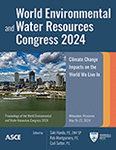Laboratory Investigation on the Breaching of Biopolymer-Treated Dams and Embankments
Publication: World Environmental and Water Resources Congress 2024
ABSTRACT
Biopolymer additives have been shown to increase soil resistance to erosion, but the utility in real world applications is unclear. Here, we present results of experiments on the role of biopolymer-treated (xanthan gum) soils to increase dam and levee resistance to breaching due to overtopping. Laboratory experiments were conducted with compacted sand with 0%, 0.05%, 0.1%, and 0.15% xanthan gum concentrations. The upstream reservoir water level was kept constant until dam failure. Breach discharge and topography were measured. Results confirm that adding xanthan gum decreases sand erodibility, and breach development in biopolymer-treated laboratory dams was slower than in untreated sand dams and failure time increases with xanthan gum concentration.
Get full access to this chapter
View all available purchase options and get full access to this chapter.
REFERENCES
ASCE/EWRI Task Committee on Dam/Levee Breaching. (2011). Earthen embankment breaching. Journal of Hydraulic Engineering, 137(12), 1549–1564. doi: https://doi.org/10.1061/(ASCE)HY.1943-7900.0000498.
ASTM. ASTM D0698. (2021). Standard Test Methods for Laboratory Compaction Characteristics of Soil Using Standard Effort (12,400 Ft-Lbf/Ft3 (600 kN-m/M3)). https://www.astm.org/d0698-12r21.html. Accessed 8 Nov. 2023.
Ge, W., Sun, H., Zhang, H., Li, Z., Guo, X., Wang, X., Qin, Y., Gao, W., and van Gelder, P. (2020). Economic risk criteria for dams considering the relative level of economy and industrial economic contribution. Science of The Total Environment, 725, 138139. https://doi.org/10.1016/j.scitotenv.2020.138139.
Chang, I., Im, J., Prasidhi, A. K., and Cho, G.-C. (2015). Effects of Xanthan gum biopolymer on soil strengthening. Construction and Building Materials, 74, 65–72. https://doi.org/10.1016/j.conbuildmat.2014.10.026.
Chang, I., Lee, M., Tran, A. T. P., Lee, S., Kwon, Y.-M., Im, J., and Cho, G.-C. (2020). Review on biopolymer-based soil treatment (Bpst) technology in geotechnical engineering practices. Transportation Geotechnics, 24, 100385. https://doi.org/10.1016/j.trgeo.2020.100385.
Dogan, M., Toker, O. S., and Goksel, M. (2011). Rheological behaviour of instant hot chocolate beverage: Part 1. Optimization of the effect of different starches and gums. Food Biophysics, 6(4), 512–518. https://doi.org/10.1007/s11483-011-9233-0.
Coleman, S. E., Andrews, D. P., and Webby, M. G. (2002). Overtopping breaching of noncohesive homogeneous embankments. Journal of Hydraulic Engineering, 128(9), 829–838. https://doi.org/10.1061/(ASCE)0733-9429(2002)128:9(829).
Hanson, G. J., Cook, K. R., and Hunt, S. L. (2005). Physical modeling of overtopping erosion and breach formation of cohesive embankments. Transactions of the ASAE, 48(5), 1783–1794. https://doi.org/10.13031/2013.20012.
Visser, P. J. (1998). “Breach growth in sand-dikes.”, Delft Univ. of Technology, Delft, The Netherlands.
O’Donal, H. (2023). Impact of Dam Height and Grain Size Distribution on Breaching of Non-cohesive Dams Due to Overtopping, University of South Carolina, MS thesis.
Feliciano Cestero, J. A., Imran, J., and Chaudhry, M. H. (2015). Experimental investigation of the effects of soil properties on levee breach by overtopping. Journal of Hydraulic Engineering, 141(4), 04014085. https://doi.org/10.1061/(ASCE)HY.1943-7900.0000964.
Ralston, D. C. (1987). “Mechanics of Embankment Erosion During Overflow,” Hydraulic Engineering, Proceedings of the 1987 ASCE National Conference on Hydraulic Engineering, Williamsburg, Virginia, August 3-7, 1987, p. 733–738.
Pugh, C. A. (1985). Hydraulic Model Studies of Fuse Plug Embankments, US Bureau of Reclamation, Denver, Colorado, December 1985, 33 p.
Powledge, G. R., Ralston, D. C., Miller, P., Chen, Y. H., Clopper, P. E., and Temple, D. M. (1989). “Mechanics of Overflow Erosion on Embankments. I: Research Activities,” Journal of Hydraulic Engineering, vol. 115, no. 8, August 1989, p. 1040–1055.
Temple, D. M. (1989). “Mechanics of an Earth Spillway Failure,” Transactions of the ASAE, vol. 32, no. 6, November-December 1989, p. 2015–2021.
Mahedi, M., Cetin, B., and Dayioglu, A. Y. (2019). Leaching behavior of aluminum, copper, iron and zinc from cement activated fly ash and slag stabilized soils. Waste Management, 95, 334–355. https://doi.org/10.1016/j.wasman.2019.06.018.
Zhu, Q. (2011). CO2 abatement in the cement industry. IEA Clean Coal Centre.
Information & Authors
Information
Published In
History
Published online: May 16, 2024
ASCE Technical Topics:
- Analysis (by type)
- Compacted soils
- Dam failures
- Dams
- Design (by type)
- Disaster risk management
- Disasters and hazards
- Embankment dams
- Engineering fundamentals
- Engineering materials (by type)
- Failure analysis
- Failures (by type)
- Geomechanics
- Geotechnical engineering
- Hydraulic engineering
- Hydraulic structures
- Load and resistance factor design
- Load factors
- Man-made disasters
- Materials engineering
- Polymer
- Soil mechanics
- Soils (by type)
- Structural design
- Structural engineering
- Structures (by type)
- Synthetic materials
- Water and water resources
Authors
Metrics & Citations
Metrics
Citations
Download citation
If you have the appropriate software installed, you can download article citation data to the citation manager of your choice. Simply select your manager software from the list below and click Download.
